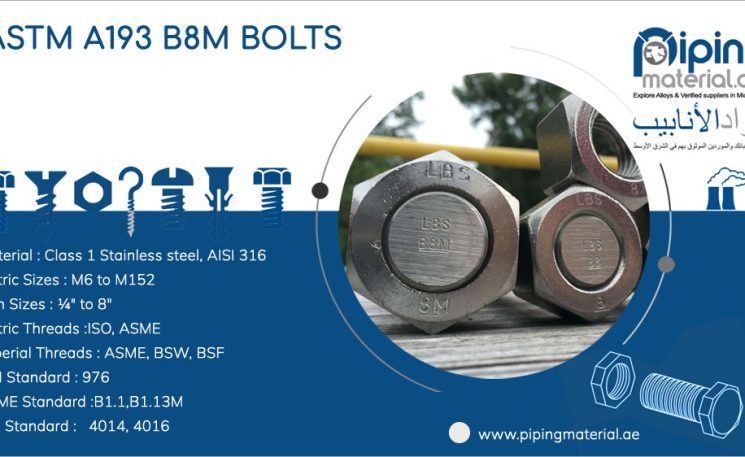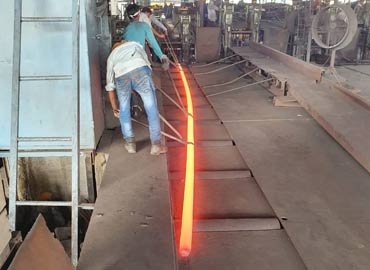A Comprehensive Guide to A193 B8m Bolts and Stainless Steel Welding Electrodes
Introduction:
When it comes to heavy-duty applications, fasteners and welding play a crucial role in ensuring structural integrity and durability. In this blog, we will explore two essential components of the industrial landscape: A193 B8m bolts and stainless steel welding electrodes. Understanding their characteristics, applications, and best practices will help you make informed decisions and achieve reliable results in your projects.
Part 1:
A193 B8m Bolts A. Overview: A193 B8m bolts are high-strength fasteners specifically designed for corrosive environments. They are part of the ASTM A193 specification, which covers a range of bolting materials used in high-temperature and high-pressure applications.
- Material Composition: A193 B8m bolts are made from stainless steel alloy grade 316, which contains a higher content of molybdenum (typically 2-3%) compared to standard 304 stainless steel. This molybdenum addition enhances the bolt’s resistance to corrosion, especially in chloride-rich environments.
- Applications:
- Petrochemical Industry: A193 B8m bolts are widely used in the petrochemical industry for equipment such as pressure vessels, valves, and pipelines, where exposure to corrosive substances is common.
- Marine Applications: Due to their excellent corrosion resistance, these bolts are ideal for maritime structures like offshore platforms, shipbuilding, and coastal installations.
- Chemical Processing: A193 B8m bolts find applications in chemical plants, where they provide reliable fastening solutions for equipment and piping systems exposed to various chemicals.
- Key Features and Considerations:
- Corrosion Resistance: A193 B8m bolts exhibit superior resistance to corrosion, particularly in environments containing chlorides, sulfuric acid, and other aggressive substances.
- Temperature Range: These bolts are suitable for use in a wide temperature range, from cryogenic temperatures up to 1000°F (537°C), making them versatile for different industrial settings.
- Strength and Load Capacity: A193 B8m bolts offer high tensile strength, ensuring secure connections and load-bearing capabilities.
Part 2:
Stainless Steel Welding Electrodes A. Overview: Stainless steel welding electrodes are consumable sticks or wires used for joining stainless steel components through the process of arc welding. They serve as a filler material that melts and forms a bond with the base metal, creating a strong, corrosion-resistant joint.
- Types of Stainless Steel Welding Electrodes:
- E308/E308L: These electrodes are designed for welding austenitic stainless steels, such as 304 and 304L grades, which are commonly used in various industries.
- E309/E309L: Suitable for joining dissimilar metals, E309/E309L electrodes are ideal for welding stainless steel to carbon or low-alloy steels.
- E316/E316L: These electrodes are used for welding stainless steel grades 316 and 316L, which offer enhanced resistance to corrosive environments.
- Key Features and Considerations:
- Corrosion Resistance: Stainless steel welding electrodes ensure that the welded joint retains its corrosion-resistant properties, maintaining the integrity of the stainless steel structure.
- Weld Quality: Choosing the appropriate electrode for the specific stainless steel grade and welding process is crucial to achieve high-quality, defect-free welds.
- Heat Input: Proper control of heat input during welding helps prevent distortion, overheating, and other issues that can compromise the structural integrity of the joint.
- Best Practices:
- Cleanliness: Prior to welding, ensure that the stainless steel surfaces are clean and free from contaminants, as they can affect the weld quality.
- Preheating and Post-Weld Heat Treatment: In certain cases, preheating or post-weld heat treatment may be necessary to minimize stress and optimize the mechanical properties of the weld.
- Welding Technique: Employ appropriate welding techniques, such as maintaining a suitable arc length, travel speed, and electrode angle, to achieve desired results.
Conclusion:
A193 B8m bolts and stainless steel welding electrodes are essential components in various industrial applications, providing strength, corrosion resistance, and reliability. By understanding their characteristics, applications, and best practices, you can ensure the integrity and longevity of your structures, equipment, and systems. Whether you’re working in petrochemicals, marine environments, or chemical processing, these components will prove invaluable in maintaining the highest standards of safety and performance.
- Share

YOU MIGHT ALSO ENJOY
Apa Peran Partai Politik dalam Sistem Politik Indonesia Saat Ini?
Stephen Romero - May 4, 2024
How Do Camp and Climb Tents Differ from Standard Camping Tents?
Stephen Romero - May 3, 2024
Acing high tensile fastener: A Comprehensive Direct
Stephen Romero - May 2, 2024
search
stay in touch
To be updated with all the latest news, offers and special announcements.

must read
Elevate Your Workplace: The Importance of Hiring Professional Office Cleaners in Brisbane
Stephen Romero - April 26, 2024
recent post
ARCHIVES
- May 2024 (3)
- April 2024 (15)
- March 2024 (19)
- February 2024 (6)
- January 2024 (7)
- December 2023 (11)
- November 2023 (1)
- July 2023 (13)
- June 2023 (21)
- May 2023 (27)
- April 2023 (23)
- March 2023 (16)
- February 2023 (31)
- January 2023 (26)
- December 2022 (11)
- November 2022 (12)
- October 2022 (11)
- September 2022 (11)
- August 2022 (14)
- July 2022 (13)
- June 2022 (19)
- May 2022 (17)
- April 2022 (10)
- March 2022 (12)
- February 2022 (8)
- January 2022 (9)
- December 2021 (19)
- November 2021 (4)
- October 2021 (6)
- September 2021 (4)
- August 2021 (4)
- July 2021 (10)
- June 2021 (6)
- May 2021 (2)
- April 2021 (2)
- March 2021 (45)
- August 2020 (31)
- July 2020 (30)
- June 2020 (29)








